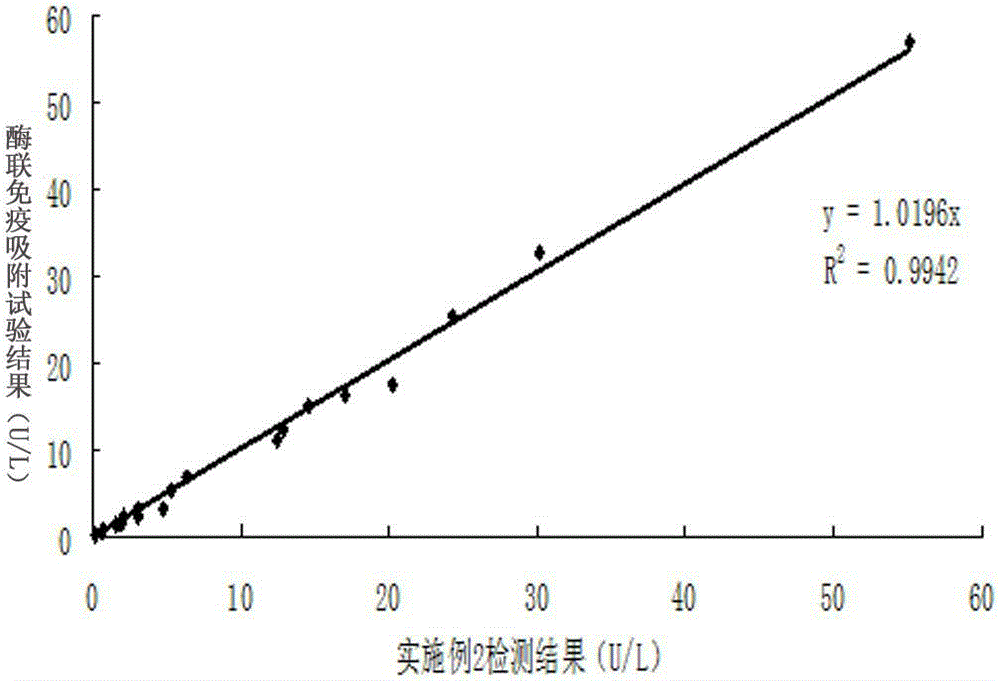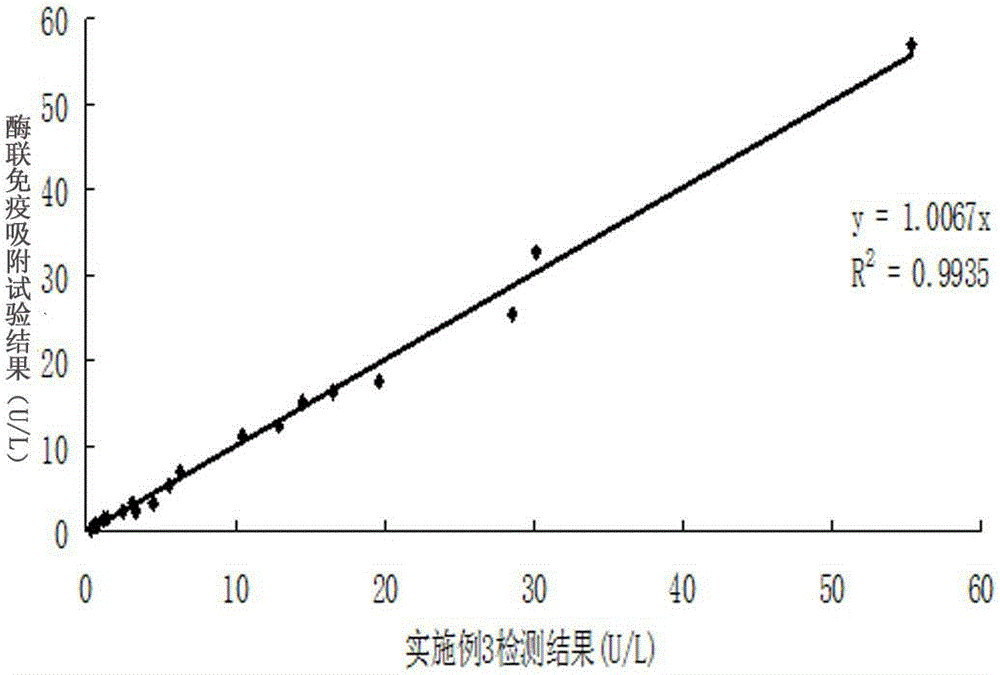Detection reagent for N-acetyl-beta-D-glucosaminidase with high analytical sensitivity
A technology for glucosamine and detection reagents, which is applied in the direction of analyzing materials through chemical reactions, and analyzing materials through observation of the impact on chemical indicators, which can solve the problems of expensive substrates, time-consuming operations, and increased cost of using departments. , to achieve the effect of ensuring specificity and accuracy, improving strong alkaline environment, and low substrate cost
- Summary
- Abstract
- Description
- Claims
- Application Information
AI Technical Summary
Problems solved by technology
Method used
Image
Examples
Embodiment 1
[0039] A traditional PNP-NAG method detection reagent, the composition of described reagent R1 and reagent R2 is as follows:
[0040] R1 reagent:
[0041] Glycine buffer 30mmol / L
[0042] p-nitrophenyl-β-D-glucosamine 16mmmol / L
[0044] R2 reagent:
[0045] Borax buffer at pH 10.2 · 100mmol / L
Embodiment 2
[0048] A NAG detection reagent with high analytical sensitivity, comprising reagent R1 and reagent R2, the composition of the reagent R1 and reagent R2 is as follows:
[0049] R1 reagent composition:
[0050] MES (2-(N-morpholine)ethanesulfonic acid) buffer solution 30mmol / L
[0051] 5-(4-(3-methyl-styrene)-rhodanine-3-acetate amino-N-acetylamino-β-D-glucoside 5.3mmol / L
[0052] Cyclohexanediaminetetraacetic acid (CDTA) 5mmol / L
[0053] Ascorbate oxidase 1KU / L
[0054] Potassium chloride 10g / L
[0055] Lithium chloride 13.5g / L
[0057] Hexadecyltrimethylammonium bromide 1g / L
[0058] 3-Sulphopropyl tetradecyl dimethyl betaine 5g / L
[0059] R2 reagent composition:
[0060] AMP100mmol / L
[0061] Triton 4053mL / L
[0062] Sodium azide 2g / L.
Embodiment 3
[0064] A NAG detection reagent with high analytical sensitivity, comprising reagent R1 and reagent R2, the composition of the reagent R1 and reagent R2 is as follows:
[0065] R1 reagent composition:
[0066] MES buffer 30mmol / L
[0067] 5-(4-(3-methyl-styrene)-rhodanine-3-acetate amino-N-acetylamino-β-D-glucoside 5.3mmol / L
[0068] Cyclohexanediaminetetraacetic acid (CDTA) 10mmol / L
[0069] Ascorbate oxidase 5KU / L
[0070] Potassium chloride 20g / L
[0071] Lithium chloride 18g / L
[0072] Sodium azide 5g / L
[0073] Hexadecyltrimethylammonium bromide 2g / L
[0074] 3-Sulphopropyltetradecyldimethylbetaine 10g / L
[0075] R2 reagent composition:
[0076] AMP100mmol / L
[0077] Triton 4055mL / L
[0078] Sodium azide 5g / L.
[0079] Respectively, the reagents obtained in Example 1, Example 2 and Example 3 were detected and used in a fully automatic biochemical analyzer with dual reagent functions, and determined by the rate method.
[0080] 1) How to use the test: put the re...
PUM
| Property | Measurement | Unit |
|---|---|---|
| wavelength | aaaaa | aaaaa |
Abstract
Description
Claims
Application Information
 Login to View More
Login to View More - R&D
- Intellectual Property
- Life Sciences
- Materials
- Tech Scout
- Unparalleled Data Quality
- Higher Quality Content
- 60% Fewer Hallucinations
Browse by: Latest US Patents, China's latest patents, Technical Efficacy Thesaurus, Application Domain, Technology Topic, Popular Technical Reports.
© 2025 PatSnap. All rights reserved.Legal|Privacy policy|Modern Slavery Act Transparency Statement|Sitemap|About US| Contact US: help@patsnap.com



